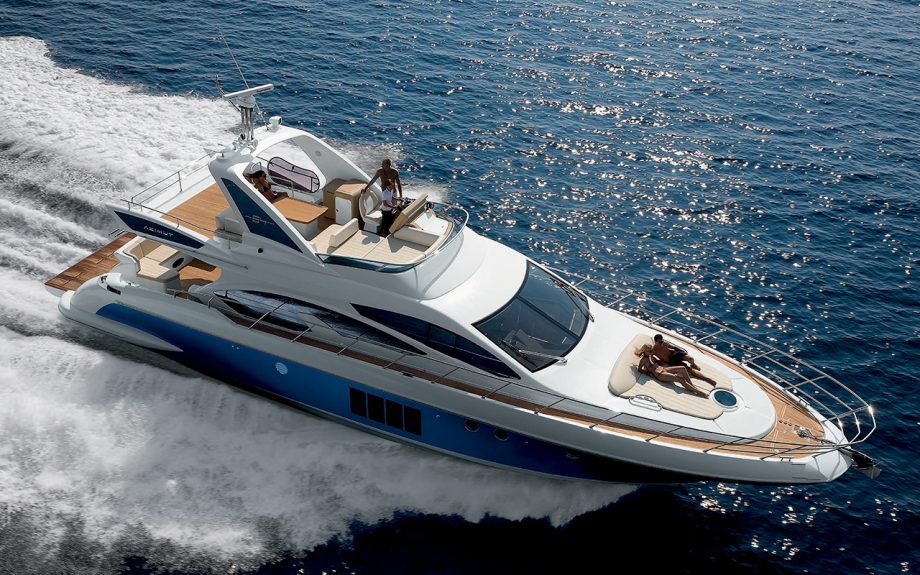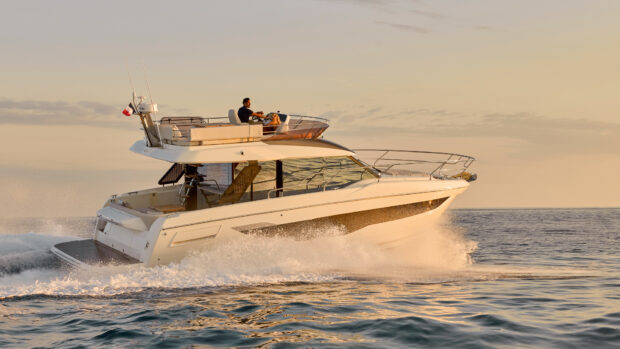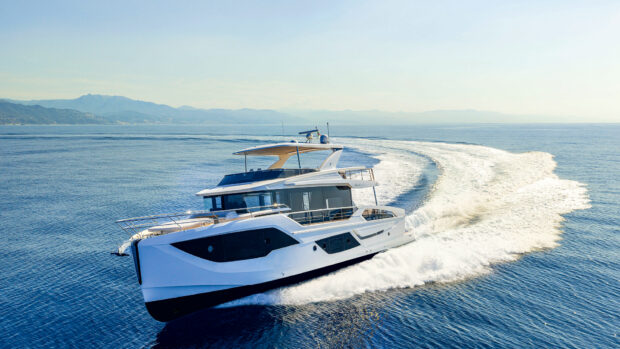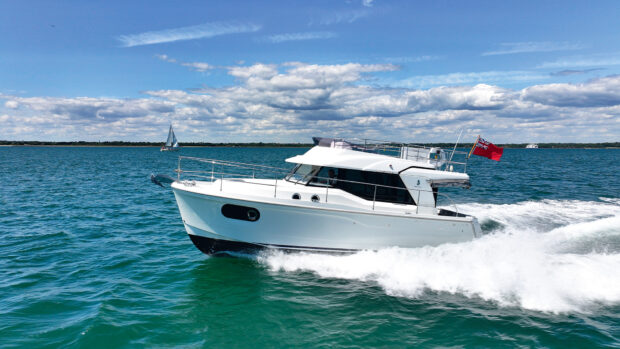She may be an all-luxury cruiser but the Azimut 64 is a heck of a lot fun for a 60-footer.
Sometimes you just have to submit to your inner nerd. Testing boats is often thought to be – by family members, by people you meet on the plane, by your tax accountant – a glamorous occupation. It’s the opposite.
The whole purpose of testing a boat is to reduce something fabulous and fun to a series of notes and numbers.
We clamber aboard armed not with suncream and Ray-Bans, but with clipboards and tape measures. The boats’ professional crews look at us with bemusement and pity.
Every so often, though, the nerd emerges triumphant. It was clear from the start with the Azimut 64 that this was no ordinary performer.
It handled as well as all of Azimut’s more recent hulls have done, providing the sort of fun, sporty drive that we really have no right to expect of a 35-tonne, three-cabin family cruiser.
And it was no slouch in a straight line either, topping out at over 34 knots. But it was the way it got there that seemed a little unusual.
Throttle inputs provided instant results – not just low down, but throughout the rev range.
Cruising comfortably at 2,000rpm, or around 28 knots, I eased the levers forward, and everyone standing on the flybridge took an involuntary step back.
This was acceleration beyond the call of duty. This was a job for my digital stopwatch.
Acceleration on tap
Normally acceleration tests on a big flybridge boat have all the elements of anticlimax, as the throttles are pushed to the stops, the engine computers think about things for a while, and then, grudgingly, allow the thirsty cylinders a miserly sip of diesel. Getting to 10 knots seems to take an age.
Twenty knots in 20 seconds is generally reckoned to be sparkling. And as the boat lumbers through the numbers, if it reaches its top speed in anything under a minute, that’s respectable.

Engine instrumentation is nicely symmetrical but ought to be paired.
With the crew looking on, her skipper manning the helm and me staring at the watch and the GPS, we had to go through the process several times, because at first I simply did not believe the data.
After several goes, in both directions (although wind and current off Cannes were negligible) we established that the Azimut 64 blasted through 20 knots in ten seconds, reached 30 knots six seconds later, and was stretching out for the horizon at terminal velocity in just over half a minute. Very, very impressive.
The crew studied the numbers with raised eyebrows and regarded the nerd, I felt, with something approaching respect.

Moveable backrest converts flybridge sunbed to sofa.
So what does this mean? It’s a further demonstration, if anyone needed it, that CAT C18 ACERTs are monumentally torquey motors. It shows that Azimut’s design engineers know what they’re doing when it comes to shaft angles, hull shapes and propellers.
And it proves, beyond doubt, that if challenged to a drag race by a Pershing 64 – or anything else with surface drives, come to that – the Azimut would walk it up to 30 knots.
Solid in the rough
There, is of course, a real-world benefit to this sort of sports-car zip, and it comes not when roaring along at maximum speed, but in choppy weather, when you’ve throttled back to minimum planing speed to reduce the pounding, and are trying to steer a course between the bigger crests.
The bottom-end grunt of the CATs ensures that the Azimut 64 will be able to stay solidly on the plane even down at 15 or 16 knots, and if she does start to wallow while crawling up the back of a big swell, the merest nudge of throttle will be enough to restore her equilibrium. Helm response is equally positive.
The sum of these parts is an excellent and exhilarating all-round drive, and a sense of complete control even when the going gets rough. Not that the sea is ever rough at the Cannes Boat Show, or at least not often.
But choppy financial waters are not unknown. Of the 64’s predecessor, the Azimut 62, more than 200 were built in nine years of production, and if Azimut-Benetti have held body and soul together during the recession more successfully than many of their Italian competitors, it is down to the sales of a few such key models.
As such, the Azimut 64 carries a weight of expectation on its slender shoulders. Sensibly, then, Azimut have stuck with the world-beating design team of Carlo Galeazzi and Stefano Righini, who between them have produced some of the most innovative and widely imitated designs of the last ten years – many of them for Azimut.
Style & functions
The distinctive Cadillac fins are signature features of Righini’s recent work for the shipyard, as is the uniquely trapezoidal bow – which brings its own practical advantages to the foredeck.
Galeazzi’s excellent interior, meanwhile, marries tactile limed oak with dark, shiny lacquer and luxurious leather, in a pleasing contrast but subtle overall scheme. There are different finishes available.
Hull and superstructure are moulded using resin infusion, with carbon-fibre reinforcement employed here and there to further lighten the structure.

She may be an all-luxury cruiser but the Azimut 64 is a heck of a lot fun for a 60-footer.
A comparison of rival boats in this class does suggest that weight-saving has been a priority on the Azimut 64, and one which has allowed the designers to fit larger-than-average fuel tanks without any penalty in full-load displacement.
The result is a cruising range of over 300 nautical miles at 32 knots, with a safe reserve.
Electronic joystick controls are offered as an option, as well as the effective and very pricey Seakeeper gyro stabiliser, which swallows up not just money but also one of the two crew berths in the stern.

Extra sunbathing space on the foredeck.
The internal layout is straightforward, with an emphasis on light and space. On the main deck this manifests itself in the huge saloon windows and the open-plan galley, which hardly interrupts sightlines through the boat, from the windscreen to the cockpit.
Living spaces
At the inside helm, a clever seat with an electrically operated base and back, as seen on other recent Azimut flybridge models, can quickly alter its aspect to face either the helm station or the dining table.
This sits opposite the galley and can comfortably seat six, or eight at a pinch. The saloon seating area is equally rational and rectilinear.

Various wood finishes are offered, as well the option of a hardwood saloon floor.
If you prefer, you can specify another sofa on the starboard side in place of the sideboard – without losing the TV – and in another option the port sofa can also be substituted for a convertible sofabed.
Down below, ample daylight is provided by large hull windows in both the master cabin, amidships, and the forward VIP suite.
The spacious central lobby is also illuminated via the windscreen above.
The master suite has an offset, full-size double berth on the port side, facing the owner’s breakfast dinette over to starboard.
The heads and shower compartment are along the aft bulkhead, along with a substantial walk-in wardrobe.
These spaces also provide some sound insulation from the engineroom.

Big windows and bags of stowage space make for a high-class VIP.
Forward, the VIP has the same size bed as the master, and the same 6ft 4in (1.95m) headroom.
One noteworthy feature of both cabins, as seen on most new Azimut flybridge models, is the hinged mattresses, which lift up on gas struts to reveal very useful volumes of accessible storage space.
The third cabin has private access to the day heads and slightly tapered 6ft 2in (1.88m) berths which have a maximum width of 2ft 6in (0.79m).
The interior of our test boat, the first Azimut 64 out of the shed, was finished to the extremely high standards we have come to expect of Azimut.
The quality of workmanship was never in doubt, but it was good to see how much thought had also gone into the sea-going safety of the interior, with sensible, rounded corners everywhere (well, almost) and good, solid handrails placed where required.
Opening windows at the galley and helm are another practical touch, and helm ergonomics and visibility were good too – that versatile seat at the lower helm works just fine.
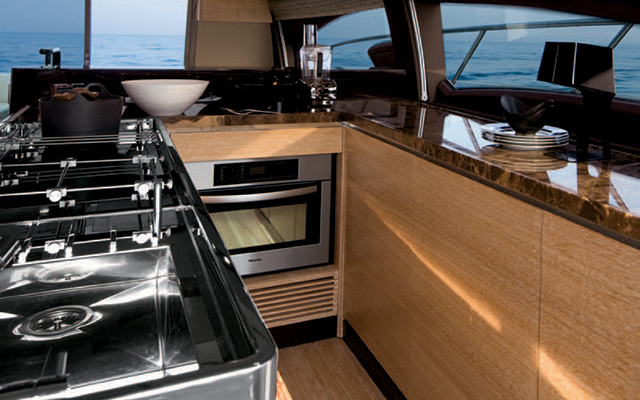
A fixed or hinged worktop is available for the galley with drawers hidden behind doors.
The Azimut 64’s exterior spaces are dominated by the long flybridge, which has ample space for a tender and crane if you wish.
However, with the 500kg-capacity hydraulic stern platform there is no real need to clutter this huge expanse of relaxation and entertaining space with anything other than prone bodies – and there is room for more on the foredeck.
The big teak table up top has useful stowage hidden in its base, and the flybridge boasts a bar unit with barbecue, sink, fridge and icemaker.
There wasn’t time to try it all out. There never is on boat tests, too many nerdy notes to take.
And there certainly wouldn’t have been at the Cannes Boat Show, from which we had escaped on the strict understanding that we’d be back in time for the crew to hose and polish before an inspection of the boat by some important prospects.
Azimut are keenly aware that those prospects are spoilt for choice in this sector of the market.
It is one of the most hotly contested in modern boatbuilding, and standards get higher with virtually every new launch. But the Azimut 64 is a supremely competent machine.

The terrific master suite has a diagonal double berth and a breakfast dinette.
It offers an impressive level of luxury and comfort, particularly if owners are prepared to dive into the options list.
And it combines this with that excellent handling and class-leading performance and a stylish Italian-eyed interior.
Whether it will also perform on the Azimut-Benetti balance sheet, we’ll have to wait and see. But I’ve got a feeling it will.
A closer look at the Azimut 64 with Alan Harper
Interior handrails

There are numerous well-positioned, chunky handrails throughout the accommodation.
They might be glamorous, but Azimuts take their sea-going responsibilities seriously, with numerous well-positioned, chunky handrails throughout the accommodation.
Crew cabin door
Access to the crew cabins is often a problem on this size of boat, but the Azimut 64’s low-profile, electric transom door is an elegant and unobtrusive solution that won’t get in the way of the tender.
Under-berth stowage
Drawers under berths are good. These are better: the mattresses of both double berths in the cabins hinge up on sturdy gas struts to provide huge, accessible volumes of stowage.
The engineroom

The engine room aboard the Azimut 64.
A ladder from the cockpit sole is the only way in. Big CAT C18s on straight shafts and a generator and air-con compressors mounted aft take up most of the available space, with fuel tanks along the hull sides.
Access to the electrical panel and weed traps at the forward end is pretty tight; but getting to the water separators and fuel filters, both aft, is not too bad.
First published in the June 2011 issue of MBY.
Details
Price from: £1.61 million
As tested: £1.66 million
Xenta joystick controls (option on test boat): £11,626
Saloon TV (37in) (option on test boat): £5,366
Teak flybridge and side decks (option on test boat): £15,592
Folding bimini top (option on test boat): £4,359
Length overall: 66ft 1in (20.15m)
Beam: 16ft 7in(5.06m)
Hull length: 63ft 2in (19.25m
Fuel capacity: 858 gal (3,900 litres)
Water capacity: 216 gal (980 litres
Draught4ft: 11in (1.51m
RCD category: A (for 14 people)
Designer: Azimut
Displacement: 35 tonnes approx (full load)



